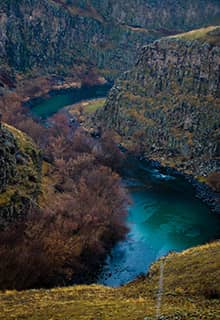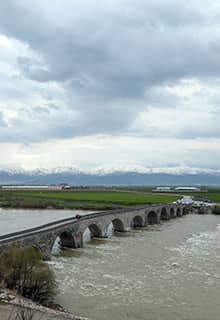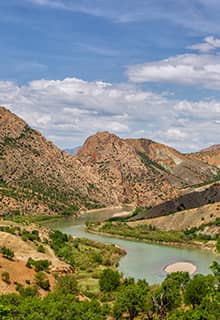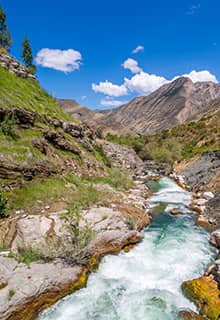

rivers Eastern Anatolia
Türkiye
Eastern Anatolia is home to the magnificent Mount Ararat and Lake Van. This region is rich in natural foliage and many stunning ski resorts, as well as breath-taking archaeological sites. If you want to escape the west and go back in time to how life used to be then this is the region for you.
The Eastern Anatolian region has rich water sources because the Euphrates, the Tigris, the Çoruh, the Aras and the Kura rivers originate here and flow into the sea on other countries.
Aras River
The Aras or Araxes or Araks is a river that starts in Türkiye and then flows along the borders between Türkiye and Armenia (including Nagorno-Karabakh), between Türkiye and the Nakhchivan area of Azerbaijan, between Iran and both Azerbaijan and Armenia, and finally through Azerbaijan to the Kura River. It drains the south side of the Lesser Caucasus Mountains and then joins the Kura, which drains the north side of Lesser Caucasus Mountains. Its total length is 1,072 km of which 548 km are in Türkiye, covering an area of 102,000 square kilometres. One of the main reasons for the importance of Aras throughout history is that it is a river that has been a border between various countries since ancient times. For example the northern borders of the Empire of Alexander the Great were based on the middle parts of this river. The Aras River is one of the largest rivers in the Caucasus.
In 2006, a bird research and education centre was established by KuzeyDoğa, a Turkish non-governmental organization for nature conservation, in the Aras Valley at the village Yukarı Çıyrıklı, in the Tuzluca district of Iğdır Province, Türkiye. It is one of Türkiye's two bird ringing stations that remain active yearly.
Murat River
The Murat River (Murat Nehri), also known as the Eastern Euphrates, is a major source of the Euphrates River. The Ancient Greeks and Romans used to call the river Arsanias. It originates near Mount Ararat north of Lake Van, in Eastern Türkiye, and flows westward for 722 km through mountainous areas. Before the construction of the Keban Dam, the Murat River joined the Karasu River or Western Euphrates 10 km north of the dam site and 13 km north of the town of Keban. In Muş Province, the river is interrupted by the Alpaslan Dams. The river merges into the reservoir of the Keban Dam, at one time Türkiye's largest dam, which was completed in 1974 and provides electrical power.
In this region, winters are harsh and especially snowy. After the snow melts in the low regions, the snow in the highlands starts to melt slowly and feeds the Murat River continuously. The presence of high mountains in the region plus a lot of snow and rain means there are many rich water springs. Various branches arising from these lush springs feed the Murat River, making it a continuous, powerful river.
Karasu River
The Karasu (which means black water) also known as the Western Euphrates is a long river in eastern Türkiye, one of the two sources of the Euphrates. It has a length of about 450 km.
The river rises on the Dumlu Dağ in Erzurum Province, and drains the plains around the city of Erzurum. It is joined by the Serçeme River, then flows west through Erzincan Province, turning south, then west and receiving the tributary Tuzla Su. Between Erzincan and Kemah it is joined by the Gönye River and passes through a rocky gorge. Near the small town of Kemaliye it receives its last tributary, the Çaltısuyu, before turning sharply southeast to flow through a deep canyon into the Keban Dam Lake on the Euphrates. Before construction of the Keban Dam the Karasu joined the Murat River 10 km above the dam site and 13 km above the town of Keban.
It is thought likely that the river Harpasos mentioned by Xenophon in Anabasis 7.18 is the Kara Su or the headwaters of the river Çoruh. When temperatures in Türkiye dropped below -25 °C in 2005 the river froze over and was used as a football pitch by the locals.








